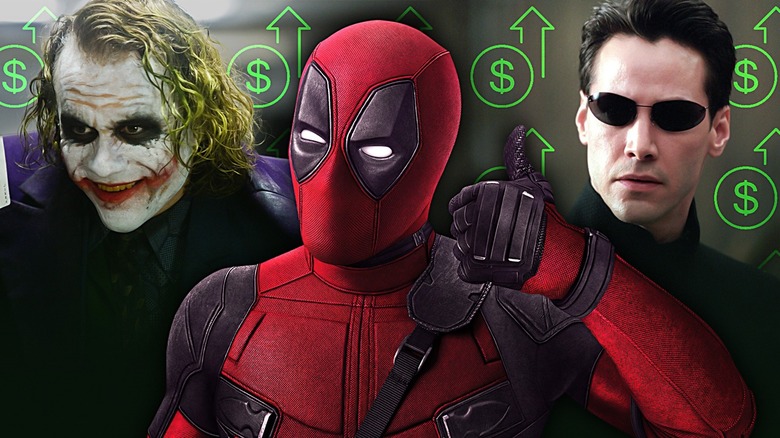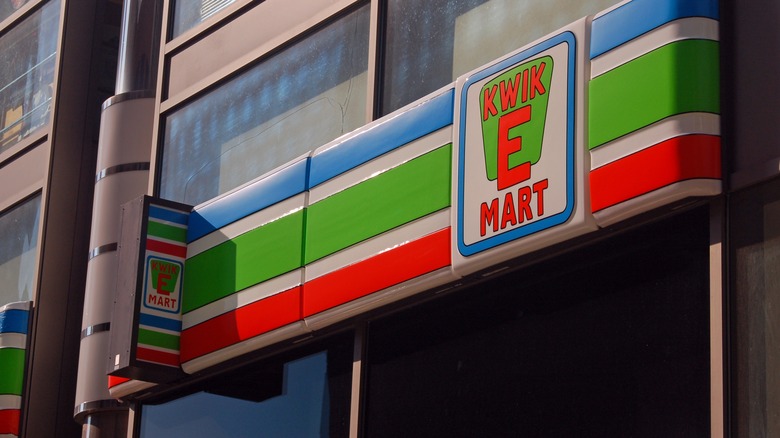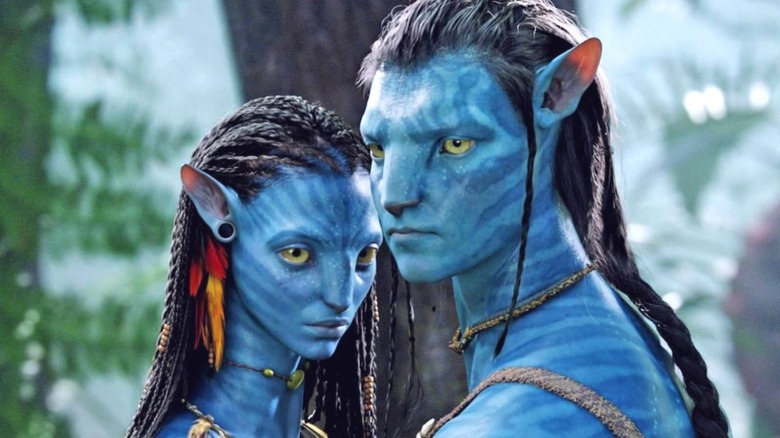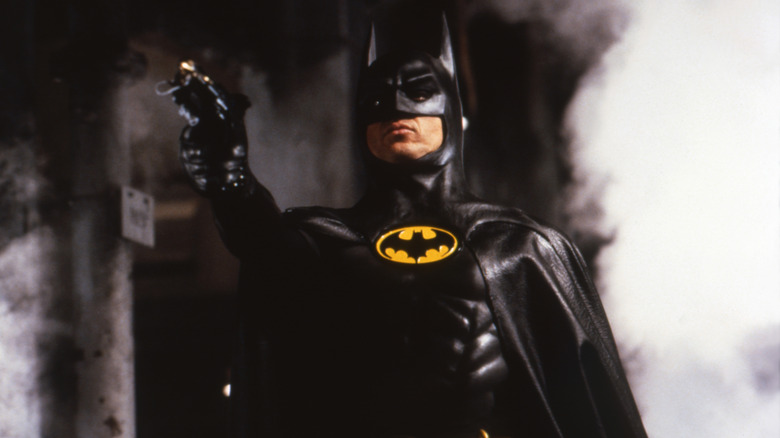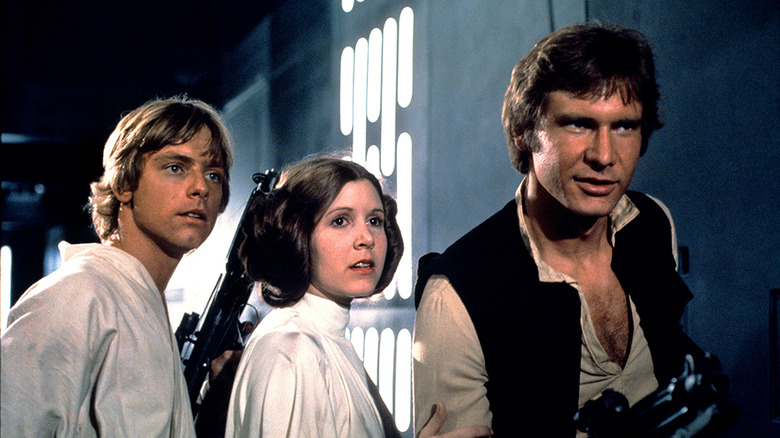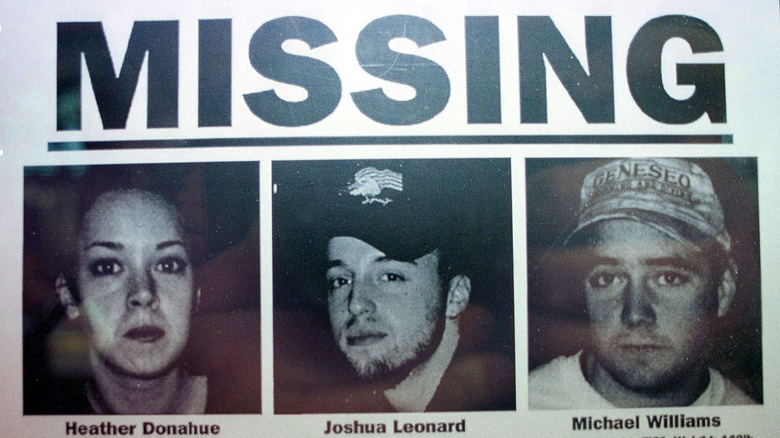The Best Movie Marketing Campaigns Of All Time, Ranked
What you may not know about Hollywood finances is that a movie's budget is often just the beginning when it comes to overall outlay. When you add in all the other costs associated with bringing a film to the big screen, studios often spend around double the stated budget. That's because a lot of money goes into a film's marketing campaign, especially when it's a big blockbuster or a highly anticipated sequel.
Movie marketing, like most other aspects of the industry, has evolved over time. Initially, movies weren't promoted beyond a poster. After a while, trailers started popping up to promote a film. That evolved further, and now movie marketing campaigns are massive affairs targeting a global audience. Not every campaign works as intended (some have even included marketing slip-ups that spoiled the movie), but every now and then there's one that knocks it out of the park, tapping into something new or approaching the challenge in a novel way.
We've compiled a list of the most memorable and successful movie marketing campaigns in Hollywood history, from classic horrors and game-changing sci-fi flicks to modern superhero juggernauts. Each of these films had wildly successful marketing campaigns in their own way, but which one takes the top spot? They're ranked by how much the film made versus how much was spent to produce and market it.
13. Toy Story 3 released some fake 1980s commercials for Lots-o'-Huggin' Bear
The "Toy Story" franchise's popularity meant that Disney and Pixar didn't need to drop a ton of cash on the third film — of course, that didn't stop them from doing exactly that! Disney focused its attention on teens and 20-somethings, hoping to tap into the nostalgia those viewers would feel having watched the first "Toy Story" film in 1995. But how was this achieved?
Disney created fake commercials, which were made to look as if they were filmed in the 1980s. One such TV spot was dated to 1983 and featured Lots-o'-Huggin' Bear. The 30-second spot has blurred static and looks like someone recorded it on their VCR in '83, so despite appearing ancient, Disney clearly put a lot of thought into creating the advertisement. Disney even created a similar advertisement for the Japanese market, which included imagery relevant to the film and a catchy jingle.
In another genius move, the Mouse House also showed the first 65 minutes of "Toy Story 3" at various colleges but cut the film before the third act, enticing viewers to flock to theaters to see what happened to their favorite toys. Additional toys and trailers helped make "Toy Story 3" a massive success.
12. The Dark Knight invited viewers into the Joker's twisted mind
"The Dark Knight" is arguably the best film in Christopher Nolan's Dark Knight Trilogy, and much of its success is attributable to Heath Ledger's Joker. Ledger sadly died six months before the film's release, though his work helped to market the movie. Warner Bros. opted for a multimedia viral marketing campaign focused heavily on the Joker's now iconic line, "Why so serious?"
Warner Bros. established several websites focused on the Joker, one of which is still online to this day. One website consisted of police reports related to the Joker and how the Gotham Police Department investigated his identity and writings. A fake kidnapping, marked $1 bills, hidden Joker cards, along with an Alternate Reality Game all came together to market the movie in new and innovative ways.
This helped to cultivate a fanbase that was ready and willing to watch the movie. That said, the film had a great deal of positive buzz and probably could have done well with a normal marketing campaign. Instead, the studio went all out in creating a viral marketing campaign that not only worked but created a template other films hoped to emulate.
11. Cloverfield let information trickle out to generate buzz
Found footage films were primarily low budget affairs until "Cloverfield" took the format and ran with it. Director J.J. Abrams came up with the concept, and as it was being produced, almost all the details were kept from the public and the media. This helped to generate some hype, but the studio didn't follow up on that by throwing images of the film's monster out there, opting to keep it concealed. The first teaser told the viewer only that something destroys New York City without going into details, and it didn't even include a title.
Part of the marketing strategy included creating fake Myspace pages for all the principal characters alongside a website that contained almost no information. By doing this, the studio tantalized its prospective audience into viewing the movie. Making a teaser or trailer without the film's title was undoubtedly a bold move, but the studio was hoping that word of mouth would work its magic, and that's exactly what happened. Essentially, the "Cloverfield" marketing campaign succeeded by keeping as much information from the public as possible.
10. The Simpsons Movie brought the Kwik-E-Mart to life
Fans waited a long time for Fox to make a movie about "The Simpsons," and it finally did so in 2007. "The Simpsons Movie" was released nearly 20 years after the show's first season debuted, so it was a long time coming. With a pre-existing fanbase, the marketing campaign could have been rather traditional, but instead of going down that route, the marketing for "The Simpsons Movie" pulled out all the stops.
The studio partnered with 7-Eleven to transform 12 stores around the country into Kwik-E-Marts. This was accomplished via an overhaul of the exterior and interior of several locations, and several in-world "Simpsons" products were available to buy, including Buzz Cola and Krusty-O's, resulting in lines out the door. Fox also partnered with Jetblue to make it the official airline of Springfield, and the studio created a website where fans could "Simpsonize" themselves into a character from the show. The marketing campaign was so successful that it earned a 2008 Creativity Award.
9. One question dominated the whole marketing campaign for The Matrix
"The Matrix" is a groundbreaking film renowned for its stunning visual effects and thought-provoking story, centering around the question, "What is the Matrix?" That question is posed to Neo (played by Keanu Reeves, who was never the same after "The Matrix") in the film, and it's also what the studio used as its primary marketing mechanism. Warner Bros. even set up the website www.whatisthematrix.com, which was advertized at the end of the film's trailer. Of course, the idea of the Matrix is embedded in pop culture today, but nobody knew what the Matrix was before seeing the movie, and that's partly what drove people to cineplexes in great numbers.
Marketing began with mysterious posters revealing the main cast in the kind of dark, leathery attire that would inform action movies for the next decade or so. This was followed by trailers that showed some of the martial arts from the film without revealing too much detail. The question "What is the Matrix?" continued to dominate marketing for the film right up to its release in the spring of 1999, when moviegoers finally got to find out for themselves.
8. Avatar had an interactive trailer
Director James Cameron is responsible for creating some of the highest-earning movies of all time, so when his name is attached to a project, people take notice. Cameron helmed "Titanic" in 1997 and didn't direct anything else for a dozen years. He released "Avatar" in 2009, and it became the highest-grossing movie of all time. To earn that distinction, the marketing campaign for "Avatar" relied on several tools, including Cameron's reputation. Audiences got their first look at the digital wizardry that went into creating "Avatar" via a 16-minute clip at over 100 IMAX 3-D theaters. On that day, news of a tie-in video game and action figures also hit the public, generating buzz, and the teaser was viewed on Apple.com more than four million times in 24 hours.
Social media engagement was utilized heavily to market "Avatar" to the public, but one thing that really made the campaign stand out from the crowd was a clever interactive trailer — it worked as a standalone ad, but if you downloaded it from the film's website, you could find out even more about the production by clicking on certain hotspots. Hidden extras included interviews with Michelle Rodriguez (Trudy Chacon) and Sigourney Weaver (Grace Augustine), as well as featurettes about the special effects. Fox updated the trailer with new content periodically, so people would have to keep going back to get all the latest intel.
7. Tim Burton's Batman revolutionized movie marketing
Tim Burton's "Batman" remains one of the best superhero movies ever made, but it had some difficulty convincing fans to come and see it. Most weren't amenable to seeing Michael Keaton take on the role of Bruce Wayne, so some folks were initially apprehensive about heading to cineplexes. However, a robust multimedia marketing campaign helped to counter this concern, and it was incredibly successful.
It's not hyperbole to say that the marketing for "Batman" changed how movies were marketed, as it injected mystery instead of focusing on details. The campaign embraced everything great about the movie and thrust it at potential viewers. Promotion of composer Danny Elfman's score and Prince's songs helped raise awareness, as did minimalist posters showing little more than the Batman symbol.
The movie effectively reintroduces the Dark Knight to existing fans while bringing him to the attention of new ones. The marketing team had to change the public perception of Batman, which at the time was still influenced by the campy TV show from the '60s. The campaign was incredibly effective in doing this, as it generated a huge buzz — or "Batmania," as it was dubbed — that helped drive viewers to movie theaters.
6. Deadpool's eccentric campaign was a masterclass in movie marketing
"Deadpool" is a highly successful film that spawned a franchise, but it almost wasn't made. Test footage was leaked, which helped generate enough online buzz for Fox to greenlight the film. Once that was done, the movie's marketing took over, and it was robust: It covered numerous types of media, and was unusual, to say the least. While Ryan Reynolds plays Deadpool, he primarily marketed the film as if he were Deadpool IRL. Reynolds did this online for very little cost.
The studio did spend some cash marketing the film, releasing comic-accurate trailers that packed in as much comedy as possible. Other promotional videos included Deadpool talking to children about the people they've killed. Deadpool even filmed a public service announcement about checking for testicular cancer. There were even billboards with emojis of a skull, poop, and the letter L to entice people to check out the film.
According to Adam Rubins, chief executive at communications agency Way to Blue, Deadpool offered Fox a unique opportunity to try something completely different. "Most great creative ideas within film marketing are usually prevented from a green light by film makers," Rubins said (via The Drum). "I would argue there are a number of fantastic film marketing campaigns that break creative boundaries, but they may not stand out as much as a 'Deadpool' simply because of the golden terrain that this particular movie gives you."
5. Andy Muschietti's It took to the streets
In 2017, a new adaptation of Stephen King's "It" hit theaters, terrifying moviegoers worldwide. The success was largely due to the brilliant performance of Bill Skarsgård as Pennywise and the talents of the makeup department. The film could have been marketed traditionally, but instead, the studio chose to go in a muted direction, using experimental guerilla marketing.
One of the primary marketing techniques involved something rather simple: a red balloon. If you know anything about Pennywise, you'll know that a red balloon is indicative of the villain's presence, so to market the movie, balloons were tied to sewer grates with the words "IT IS CLOSER THAN YOU THINK. #ITMOVIE IN CINEMAS SEPTEMBER 7" painted on the ground.
There was also a huge social media campaign aimed at directing people to the movie's website. Very little was revealed in trailers or any promotional material, leaving potential viewers wondering just how frightening Pennywise was going to be in the film. Steven King even got on board, praising Andy Muschietti's movie on his X (formerly known as Twitter) account. His blessing was the cherry on the cake of a marvelous marketing campaign.
4. People lined up around the block for Star Wars following a successful marketing campaign
If you're a fan of the galaxy far, far away, then you've probably wondered what it was really like to see "Star Wars" in 1977. The first film in what would become one of Hollywood's most dominant franchises was a huge success, and marketing was a big part of that. The main cast all hit the TV and radio circuit to drum up interest (something that was less common back then compared to today), and hype was generated via the release of a book and a comic in 1976. By the time the film hit cineplexes, anticipation was high — it even made the cover of Time magazine, which undoubtedly drove even more people to see it. People were lining up around the block for tickets.
Future Star Wars films had an advantage over the first one because they were helped by the popularity of the tie-in toy line. In his agreement with 20th Century Fox, creator George Lucas received all of the merchandising rights for a smaller director salary, a move that would make him a rich man. The value of tie-in merchandise was suddenly clear — Lucas effectively established a new industry model for both marketing and merchandising that films have replicated ever since. The buzz around the toys fed into future films and vice versa, creating a loop that pushed Star Wars into the stratosphere.
3. Alfred Hitchcock made Psycho seem like a real story
Of all his amazing films, Alfred Hitchcock's "Psycho" remains the director's most famous. The movie is interesting in that it begins with a large focus on its star, Janet Leigh, but kills her in the first act ("Psycho" ultimately changed Leigh's career forever). It was a shocking move considering that Leigh was an A-list star at the time, and Hitchcock took full advantage of her involvement during marketing. Horror was still very much a B-movie genre when the film was made, so Hitchcock made sure to let potential viewers know that a big name actress was on board, giving "Psycho" a certain pedigree.
Perhaps the most ingenuous element of "Psycho" in terms of marketing is the way that Hitchcock presented the movie as a true story. The film's original trailer played more like a news report, with Hitchcock himself taking viewers on a tour of the Bates house. He recounts the events of the movie as though they were fact — without spoiling the twist, of course. The filmmaker also created an actual manual for viewers, warning them that watching the movie may lead to health scares, and he even went as far as employing "real" nurses to attend screenings, adding to the illusion that seeing "Psycho" was a genuinely dangerous undertaking.
2. The Blair Witch Project redefined guerilla marketing
There were viral marketing campaigns before "The Blair Witch Project" hit movie theaters, but this film arguably redefined the technique. The found footage horror flick was inexpensive to film, costing only $60,000, but it had a marketing budget of $10 million max. While that's significantly more than production cost, it's not a great deal of money for a widespread, multimedia marketing campaign, which is where viral marketing came into play.
"The Blair Witch Project" used relatively inexpensive means to market the film. One such method was a website that looked like a bunch of college students put it together. Instead of focusing on the movie itself, the site focused on the myth of the Blair Witch, generating buzz about something that didn't exist before the film. There was also a heavy marketing presence in message boards and chat rooms, helping to generate more buzz.
On top of those methods, the marketing campaign involved the creation of missing person leaflets for the three students in the film. This helped to plant stories that made it seem like "The Blair Witch Project" was exactly what it appeared to be — a found footage account of a spiritual threat that resulted in the loss of three people. It was brilliant, inexpensive, and worked incredibly well.
1. The trailer for Paranormal Activity was genius
If "The Blair Witch Project" redefined viral marketing, it's fair to say that "Paranormal Activity" perfected it. The film was also inexpensive, costing only $15,000 to produce. Seeing as it made over $193 million at the box office, it's one of the most financially successful films ever. Still, it needed to draw people to movie theaters, and it did so via a unique strategy that involved showing people watching the movie.
The first step in marketing "Paranormal Activity" was to show it to people in a limited screening at the Screamfest horror film festival. The movie had a great premiere at Screamfest, with Katie Featherston winning best actress, but the best thing to come out of the festival was the audience reaction. As the film was generating a buzz for how scary it was, the marketing campaign created a trailer showing footage of people watching the movie, and it worked amazingly well. There are a few shots from the actual movie, but the focus of the trailer is on the audience — watching their reactions creates a tantalizing effect that makes the viewer want to see what could be so scary.
That was only one aspect of the campaign: The film's website included a "Demand It" feature, where people could vote to have the movie shown in their city. Paramount was widely praised for its inventive marketing, with Entertainment Weekly saying that execs should "be commended for bringing a touch of old-school groundswell marketing to an age of knee-jerk, top-down media saturation."
